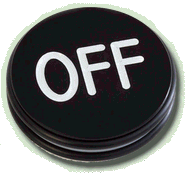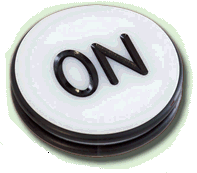| ||||||||||||||||||||
| ||||||||||||||||||||
|
The Basic Game and the Pass Line Bet pays 1/1 The operator indicates the start of a round by placing a plastic disc on the table showing the word OFF.
The shooter (and any other players who want to bet on him) places a bet on the Pass Line. |
|
The first roll of the dice is called the Come-Out Roll. The two dice are rolled and the total on the dice is counted. Here are the possible outcomes:
- 7 or 11 This is called a natural. All bets on the Pass Line WIN. This pays 1/1 so if you bet $5, you receive $5 plus your $5 stake back. The round is finished.
- 2,3 or 12 This is called craps and all bets on the Pass Line LOSE. The round is finished.
- 4,5,6,8,9 or 10 Whatever number rolled is called the Point and the round continues...
|
If a point is thrown, the operator flips the plastic disc over to show the word ON and places it on the table to indicate which point is active.
The shooter keeps rolling again until:
|
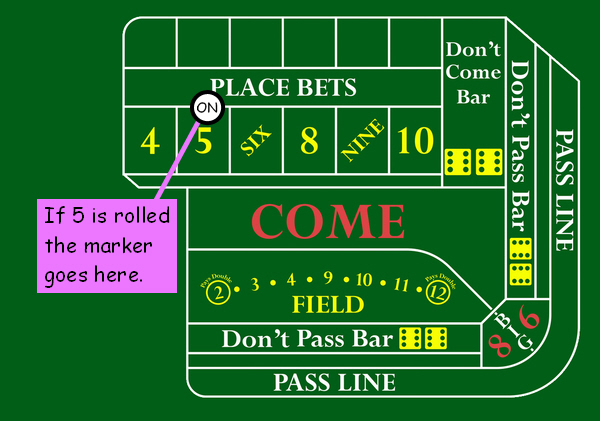
|
What are your chances of winning on the Pass Line?
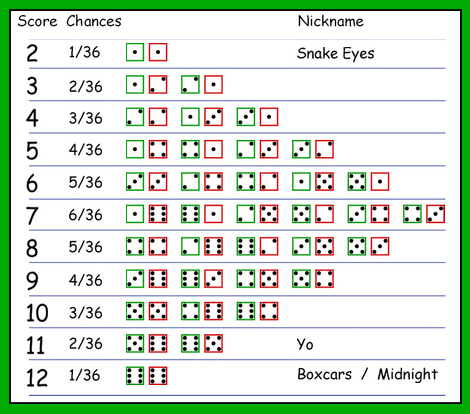 Before we look at any other bets, let's see how likely we are to win the simplest Pass Line bet.
Before we look at any other bets, let's see how likely we are to win the simplest Pass Line bet.
Two normal dice can land in 6 x 6 = 36 different ways.
To win on the Come-Out roll, we need to throw 7 or 11. There are 6+2 = 8 ways of doing this so the chance is 8/36 = 22.22%
To lose on the Come-Out roll, we need to throw 2,3 or 12. There are 1+2+1 = 4 ways of doing this, so the chance is 4/36 = 11.11%
The chances of getting a point and needing to roll again are 24/36 = 66.67%.
 To work out our chances of winning on a point, we look at the individual point score chances.
To work out our chances of winning on a point, we look at the individual point score chances.
 Suppose the come-out roll is 4. The chance of this is 3/36. After that, we have three ways of rolling 4 against six ways of rolling 7. In total there are nine winning or losing rolls. (There are also 27 ways of rolling something else, but that doesn't count as we roll again.) This means once we have rolled a 4 point, our chances of rolling it again and winning are 3/9. Our chances of rolling a 7 and losing are 6/9. Therefore, before the round starts, our chance of winning with a 4 point is 3/36 x 3/9 = 2.78%. The chance of losing with a 4 point is 3/36 x 6/9 = 5.55%
Suppose the come-out roll is 4. The chance of this is 3/36. After that, we have three ways of rolling 4 against six ways of rolling 7. In total there are nine winning or losing rolls. (There are also 27 ways of rolling something else, but that doesn't count as we roll again.) This means once we have rolled a 4 point, our chances of rolling it again and winning are 3/9. Our chances of rolling a 7 and losing are 6/9. Therefore, before the round starts, our chance of winning with a 4 point is 3/36 x 3/9 = 2.78%. The chance of losing with a 4 point is 3/36 x 6/9 = 5.55%
The chances for the other point rolls are worked out in a similar way.
In total, adding up all the winning and losing chances...
The chance of winning a pass line bet = 49.29%
The chance of losing a pass line bet = 50.71%
The House Edge
The difference between the winning and losing chances on the Pass Line = 1.42%. This creates a profit for the casino called the house edge. In real money this means that the casino can expect to keep $1.42 for every $100 you bet.
With 98.58% RTP, craps has a much higher return rate than most slots that make up the majority of games in gambling halls or online casinos and their sister sites.
Note: the house edge in Roulette is at least 2.7%, so craps is better value for the player! The house edge for Blackjack depends on the skill of the player. At best it can be as low as 0.5%, but more usually it's 2%.
Players that want to try online games can practice with a deposit as low as five dollars.
Other Craps Bets
 Don't Pass pays 1/1
Don't Pass pays 1/1
In the early days of casinos, a lot of people tried to cheat using weighted dice. This problem was overcome by an American dicemaker called John H Winn (what a good name for a gambler!) who devised the "Don't Pass" Bet. If players got suspicious, they could either bet with the shooter or bet against him.
The "Don't Pass" bet is almost the opposite of the pass line bet. The bet pays 1/1 if the come-out roll is 2 or 3, and it loses if the come-out roll is 7. If a point is rolled, the bet wins if a 7 comes first, and loses if the shooter makes the point again.
The only difference is that if the come-out roll is 12, then the bet is pushed - i.e. it becomes void and the stake is returned. This ensures that the house still has a winning edge.
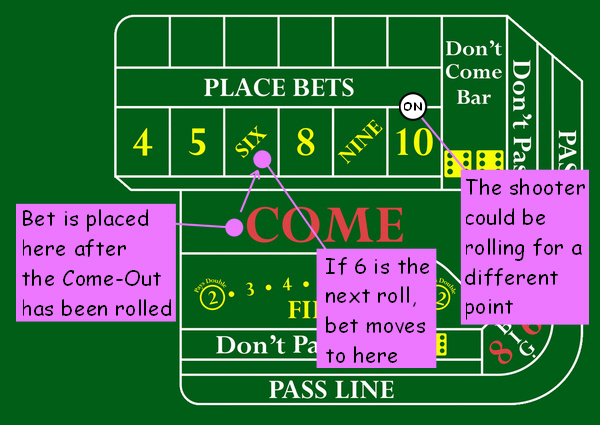 Come / Don't Come pays 1/1
Come / Don't Come pays 1/1
These bets are very similar to Pass/Don't Pass pass bets, only they are made after the come-out roll, once a point has been made.
If the next roll after your Come bet is placed is 7 or 11, you win. If it's 2,3 or 12, you lose. If it's 4,5,6,8,9 or 10 then your bet token is moved to the appropriate point number on the table.
If your bet has moved to a point, then you win if the point is rolled before a 7, and you lose if a 7 is rolled first.
A Don't Come bet works the other way round, unless the first roll is 12, in which case the bet is pushed.
Note: If the shooter makes his point before the come point is made, the come bet still remains in place until the come point or any 7 is rolled.
 Odds payout varies
Odds payout varies
If you have bet on the Pass Line and a point (4,5,6,8,9 or 10) is established, you can then add a further bet on the point being rolled before the 7.
The payout on Odds bets depends on the point number (e.g. it's more likely for the shooter to make a point of 8 than a point of 10).
| PASS LINE ODDS | |
| Point | Payout |
| 4 or 10 | 2/1 |
| 5 or 9 | 3/2 |
| 6 or 8 | 6/5 |
These odds are exactly the same as the chances of winning in each case, so there is no house edge! However casinos do put a limit on how big Odds bets can be, usually a maximum of 5x your original Pass Line bet.
Don't Pass Odds payout varies
| DON'T PASS ODDS | |
| Point | Payout |
| 4 or 10 | 1/2 |
| 5 or 9 | 2/3 |
| 6 or 8 | 5/6 |
If you have bet on the Don't Pass Line, you can bet that 7 will roll before the point number. The payouts are in reverse of the Pass Line Odds payouts, and again there is no house edge.
For example, you bet on "Don't Pass" and 9 is thrown. You then take a "Don't Pass Odds" bet on the 9 e.g. $10. If 7 comes up before the 9, you win 2/3 x 10 = $6.67 plus you get your stake back, so the total payout = $16.67.
There are also Come Odds and Don't Come Odds which work with the Come/Don't Come bets in the same way.
Field pays 1/1 or more

You can have a quick bet just on the next roll of the dice.
If 5, 6, 7 or 8 is rolled, you lose.
If 3, 4, 9, 10 or 11 is rolled it pays 1/1.
If 2 or 12 is rolled it pays 2/1.
To work out the House Edge, suppose the dice are rolled 36 times, each combination on average will come up once. If you bet $1 every time, it will cost you $36. The table shows your total return will be $34. This makes the house edge 2/36 = 5.56%. However some casinos like to make a field bet more attractive, so they might pay 3/1 on a roll of 12, which reduces the edge to 2.78%.
Big 6 / Big 8 pays 1/1
This is possibly the simplest bet on the table. You can bet that a 6, or bet that an 8 will appear before a 7.
The chances of either happening are 5/11 which gives a rather thick house edge of 9.1%. It's a simple bet, for a simple person.
|
Further Bets
There are many other ways of betting on craps, but it's worth bearing in mind that almost all of them have a higher house edge than the basic Pass Line bet, so unless you're desperate for a bit of fun, they should probably be avoided! One example is a Proposition Bet where you might gamble on the next roll being ace/deuce (i.e. a score of 3). It pays 15/1 which sounds nice, but let's check the sums. Your chances of the ace/deuce coming up are 2/36. Suppose the dice are rolled 36 times, and each combination comes up once. You bet $1 every time, so it will cost you $36. You will win twice, getting $15 plus your $1 stake back each time. So your return will be $32, your outlay will be $36 and the house edge works out to be 4/36 = 11%. Maybe if you're down to your very last bet and you want a quick make or break, then it's worth a try, but otherwise it is NOT recommended! |
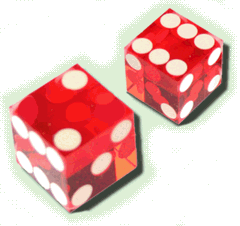
|
Blackjack - Hit, Stand, Double Down or Split?
The Betting Guide - and how to work out the Bookie's profit!
The Roulette Wheel ... and how to worry the casino!
The One-Armed Bandit Slot Machine
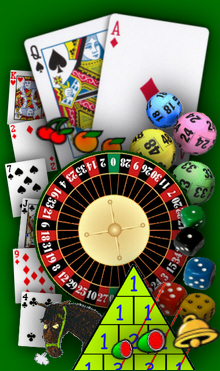 There are more stats and facts about games here:
There are more stats and facts about games here:
